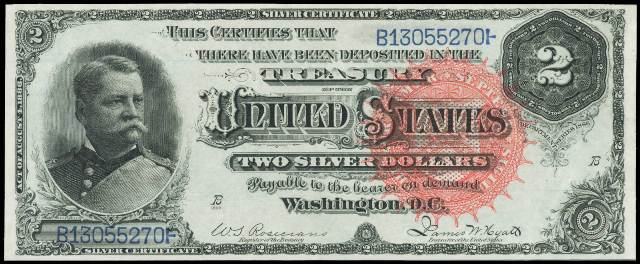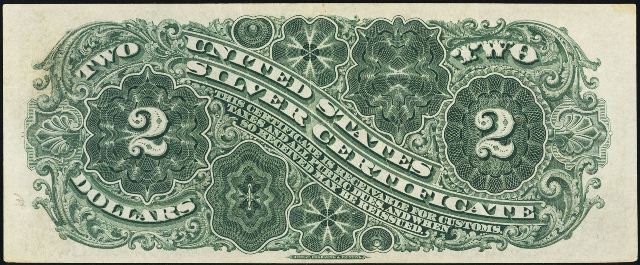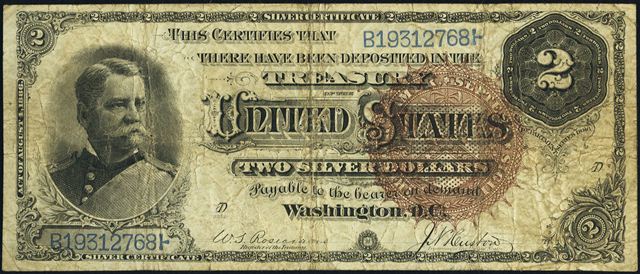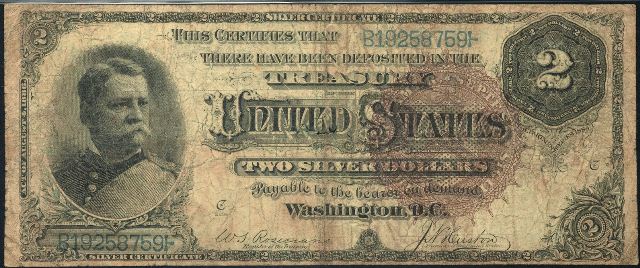Series of 1886 $2 Silver Certificate – Hancock Note
History: 1886 marks the first year that silver certificates were issued by The United States. They were issued for the one, two, five, ten, and twenty dollar denominations. Fortunately for collectors, the $1 bills and $2 bills are relatively common and affordable. The higher denominations can be quite expensive. We are specifically looking at the 1886 $2 bill for our guide here. If you are collecting coins it might costs thousands or tens of thousands to buy something like the “first silver dollar” or “first gold eagle.” That is one of the appeals of paper money collecting. You can buy an item like the first two dollar silver certificate ever made for very reasonable prices.
Nickname: Some bank notes have catchy names based on their artwork like the bison or battleship note. Sadly, the 1886 $2 silver certificate isn’t that lucky. Most collectors just refer to this note as a Hancock. The mustachioed man on the left hand side of the bill is General Winfield Scott Hancock. This is the only piece of paper money he was ever featured on; so you can comfortably call the 1886 $2 bill a Hancock without any confusion.
Other Facts: 1886 $2 silver certificates are what collectors call a one year design type. That means that later and previous issues did not borrow from this design. It is completely unique. Because of that fact, the 1886 $2 bill falls into a lot of collector areas. If you specialize in silver certificates, two dollar bills, or design types, then you have to have a Hancock note in your collection. That doesn’t mean that the note is especially popular or valuable. However, it is an interesting item that is on lots of want lists.
Values and Grading: Most 1886 $2 silver certificates are valued based purely on their condition. There are only three different signature combinations used for this series. Your exact bill will be signed by Rosecrans and Jordan, Rosecrans and Hyatt, or Rosecrans and Huston. There were three different seal types used on 1886 $2 bills. They can have small red seals, large red seals, or large brown seals. All of that information is good to know, but none of that really affects the value. Star notes were not issued until 1910, so no 1886 $2 star notes were printed. We frequently see serial numbers under 100 for this series. Obviously someone either at the Bureau of Engraving and Printing or within the government kept many of the low numbers. Most are now held by collectors. Our guide below shows you how to grade and value your specific 1886 $2 bill. Contact us if you need help with the value.
Choice Uncirculated or Better: High grade 1886 $2 silver certificates can in theory grade anywhere between a 62 and 70. Most examples will be a 64 or 65. The centering has to be especially square in order to get much higher. There are lots of high grade 1886 $2 bills available to collectors today. They aren’t rare, just expensive. Most can be bought for close to $4,000. As with any note, as the grade goes up, so does the price.

The Colors And Details On This 1886 $2 Silver Certificate Are Both Vibrant
Extremely Fine to About Uncirculated: 1886 $2 silver certificates tend to come very nice or very rough. We don’t see many in the 40 to 58 range. The note we have pictured actually graded a 40 out of 70. There is a pretty obvious center fold. There also appears to be a slight stain in the top margin. Both of those may seem extremely minor. However, you have to remember that prospective buyers are going to be as critical as possible. If it looks like a fold, then it probably is. Price in this grade range from $800 to $1,500.

1886 $2 Bills In XF Or AU Condition Can Look Perfect At First Glance
Fine to Very Fine: Fine and very fine grades are what most people would call average condition or lightly circulated. If you reached into your wallet and pulled out a respectable looking $1 bill, it would probably technically grade somewhere between Fine 12 and Very Fine 35. There are lots 1886 $2 silver certificates available in this grade. Prices range from around $300 to $750. The 1886 $2 bill we have pictured graded as a 15. The only difference between it and something lower grade would be in the quality of the paper. Obviously, something graded as a very fine 35 would look considerably nicer and would be worth a good bit more money.

This 1886 $2 Silver Certificate Is Heavily Circulated But It Still Looks Nice
Very Good and Lower: The 1886 $2 silver certificate we have pictured would probably grade an 8 or 10 out of 70. It is ugly and dark, but it is fully intact. Notice how the details in the seal are almost completely gone. Most notes like this are going to have a significant condition issue they have acquired from years in circulation. This could be a tear, split, stain, damage, or missing piece. The note we have pictured would probably sell for around $175.

Most 1886 $2 Bills Will Look Better Than This Very Good Graded Example
Need an Appraisal or Offer? We buy any and all 1886 $2 silver certificates. Just send us an email if you would like a quote on yours. We need to see scans or digital photos of the front and back of your bill. We will respond quickly with an offer. Sales@AntiqueMoney.com


